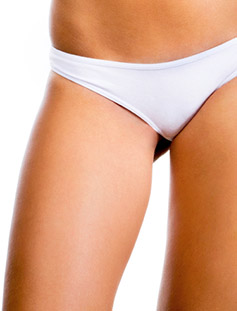
Medial Thigh Lift
What is a media thigh lift?
Substantial weight loss or age can cause the skin on the inner thigh to become loose and saggy. Because this is also a common area for fat to deposit, this can cause irritation from constant chafing.Liposuction alone to the medial thigh is often not ideal because the skin is so thin and won’t contract well thereby leaving contour irregularities and dimpling that can be visible. However, if liposuction is limited to the deeper fat and is done in a gentler fashion, often these contour irregularities can be minimized. However, with the approach of liposuction alone to the medial thighs, patients should aim for a 50% improvement overall.
If a more contoured approach is needed (as is often the case in patients with significant weight loss), then a combination of liposuction and skin excision will be the best approach.- this is called a medial thigh lift.
A medial thigh lift involves removing the excess fat by liposuction, then excising the excess skin to re-contour and shape the inner thigh. The scar will extend vertically from the junction of the inner thigh and groin, down towards the knee. Every effort is made to keep the length of the scar as short as possible, it varies from case to case depending on the degree of skin excess. Often an extension along the groin crease is required. This procedure is often complimented with liposuction around the inside of the knee to improve the final shape.
Pre Surgery Instructions
Before the procedure
No aspirin or blood thinning medications for two weeks prior to surgery. Fasting begins at midnight the night before surgery. Any medications that you take in the AM may be taken with a sip of water (except for blood thinning medications).If you get ill prior to surgery please notify us.
The Surgery
During the procedure
A medial thigh lift is typically done using general anesthetic although it may also be done under a regional or epidural anesthetic. It takes roughly 3 hours and is a day surgery procedure (no overnight stay is required). Only dissolvable sutures are used and a compression garment is applied at the end of the procedure.After Your Surgery
Post procedure
While In Hospital or Clinic
You will be in the recovery room anywhere from 1-3 hours where the team will ensure you are comfortable, eating and drinking, walking and able to urinate.
On discharge home
Immediately upon discharge from the recovery room, you are encouraged to rest under supervision and start a light diet as tolerated.
You will have been given a prescription for antibiotics that is started when you return home from surgery and is taken for 1 week.
The best position for your legs is to keep them up (on an ottoman, couch or bed). Although keeping them elevated all day is not necessary, the more that they are elevated the less swelling ensues.
You will have been given a prescription for antibiotics that is started when you return home from surgery and is taken for 1 week.
The best position for your legs is to keep them up (on an ottoman, couch or bed). Although keeping them elevated all day is not necessary, the more that they are elevated the less swelling ensues.
Day 1
You should be up and walking, drinking fluids, taking your antibiotics and pain medication as described below. Increase activity as tolerated, but there is no heavy lifting for 4 weeks. Leave the dressings alone until your first visit to the office after surgery.
What do I take for pain?
If you have pain, you are encouraged to start with:
Two Tylenol extra strength (total of 1000 mg of Tylenol) and one Advil extra strength (400 mg of Advil) to be taken at the same time as they work by different mechanisms and work very well together.
You can take the above three pills (two Tylenol extra strength and one Advil extra strength) every 8 hours around the clock for the first day or two. This is often sufficient for pain medication and can avoid the need for stronger medications such as narcotics (Percocet, Tylenol #3 etc.).
However, you will also have a prescription for a stronger pain medication that can be taken as needed if the Tylenol and Advil combination mentioned above does not suffice. This stronger pain medication may be taken on top of the above regimen. Please ensure the maximum dose of Tylenol in 24 hours does not exceed 4000 mg.
** Please be aware that with any medication and particularly Advil (a type of non-steroidal anti-inflammatory) there are risks of allergy, severe allergy, gastro-intestinal bleeding and stomach ulcers. Taking your medication with food can sometimes help with some of the stomach symptoms.
A post-operative compression wrap with tensor bandages and the underlying gauze dressings are left in place for 2-4 days. During this period of time, you may use a hand held shower or sponge bath but the dressings must stay dry.
Two Tylenol extra strength (total of 1000 mg of Tylenol) and one Advil extra strength (400 mg of Advil) to be taken at the same time as they work by different mechanisms and work very well together.
You can take the above three pills (two Tylenol extra strength and one Advil extra strength) every 8 hours around the clock for the first day or two. This is often sufficient for pain medication and can avoid the need for stronger medications such as narcotics (Percocet, Tylenol #3 etc.).
However, you will also have a prescription for a stronger pain medication that can be taken as needed if the Tylenol and Advil combination mentioned above does not suffice. This stronger pain medication may be taken on top of the above regimen. Please ensure the maximum dose of Tylenol in 24 hours does not exceed 4000 mg.
** Please be aware that with any medication and particularly Advil (a type of non-steroidal anti-inflammatory) there are risks of allergy, severe allergy, gastro-intestinal bleeding and stomach ulcers. Taking your medication with food can sometimes help with some of the stomach symptoms.
A post-operative compression wrap with tensor bandages and the underlying gauze dressings are left in place for 2-4 days. During this period of time, you may use a hand held shower or sponge bath but the dressings must stay dry.
First post-operative appointment
The initial dressing change is done on day 2-4 after surgery. The gauze is removed and the white skin tapes are left on. The tensors are wrapped back on the legs for the first two weeks.
Second post-operative appointment
The second appointment is close to 2 weeks after surgery and the white skin will be removed. The compression garment is placed on the arms and used day and night (except for the shower) for the next 3 weeks.
Post-operative swelling and bruising begins to subside after 7-10 days but can take up to 2-4 weeks for the initial 70% of swelling to resolve.
As swelling can persist for 6 months, it will take that long to see the final results particularly where liposuction has been used.
Patients usually require 1-2 weeks of downtime and should avoid strenuous exercise for 4-6 weeks.
Silicone gel sheeting is used for scar management (you will get this from the office) and starts around week 3.
The scars will take 12-18 months to fully mature and fade. Silicone gel sheeting is the best product to help with scar maturation and is used for 2-3 months following surgery.
Post-operative swelling and bruising begins to subside after 7-10 days but can take up to 2-4 weeks for the initial 70% of swelling to resolve.
As swelling can persist for 6 months, it will take that long to see the final results particularly where liposuction has been used.
Patients usually require 1-2 weeks of downtime and should avoid strenuous exercise for 4-6 weeks.
Silicone gel sheeting is used for scar management (you will get this from the office) and starts around week 3.
The scars will take 12-18 months to fully mature and fade. Silicone gel sheeting is the best product to help with scar maturation and is used for 2-3 months following surgery.


